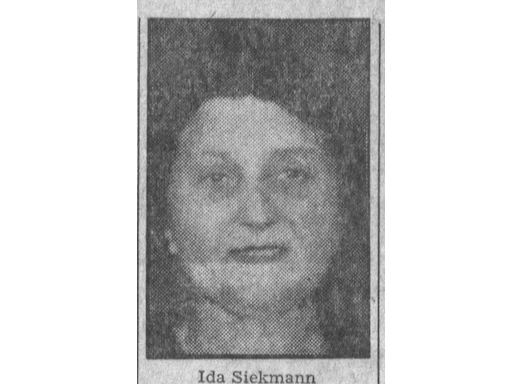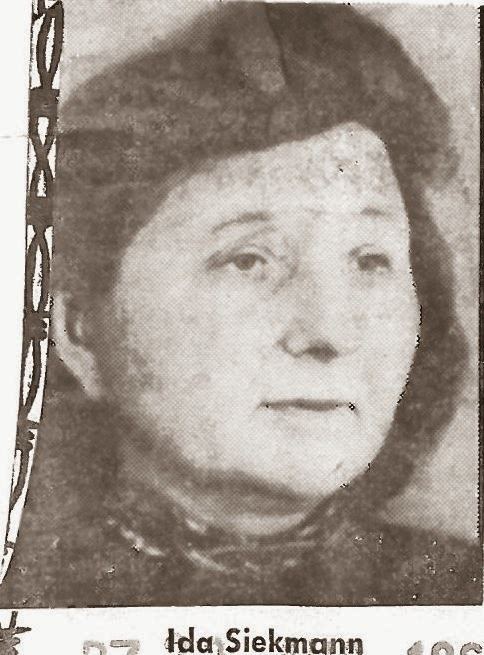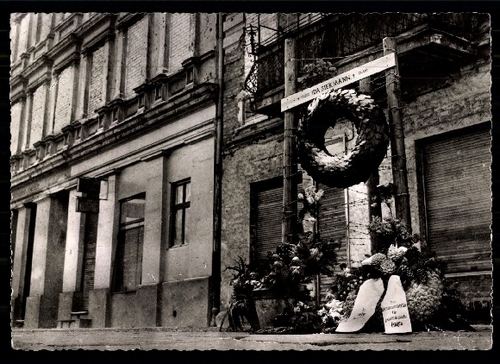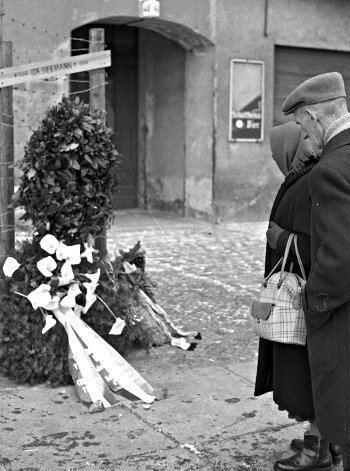Name Ida Siekmann | ||
 | ||
Born 23 August 1902 ( 1902-08-23 ) Gorken Body discovered Bernauer Strasse 4852°32′25″N 13°24′10″E / 52.5402°N 13.4029°E / 52.5402; 13.4029 (Site of Ida Siekmann fatality) Resting place Urnenfriedhof Seestrase Berlin-Wedding52°33′08″N 13°21′16″E / 52.5521°N 13.3544°E / 52.5521; 13.3544 (Location of Ida Siekmann's grave) Monuments "Window Of Remembrance", Berlin Residence Bernauer Strasse 48, Berlin N58, GDR Died August 22, 1961, West Berlin | ||
iDA SIEKMANN
Ida Siekmann (23 August 1902 – 22 August 1961) was the first person to die at the Berlin Wall, only nine days after the beginning of its construction.
Contents

Biography

Ida Siekmann was born in Gorken near Marienwerder (West Prussia) (now Górki, Kwidzyn County, Poland). She had moved to Berlin where she worked as a nurse, and lived at Bernauer Straße 48 in the center of Berlin. She had a sister, Martha L., who lived only a few blocks away, on Lortzingstraße. As of August 1961, she was already a widow; it is not known when she was widowed.

After World War II, Berlin was divided in four Allied sectors. While the street and the sidewalk of the Bernauer Straße lay in the French sector of West Berlin, the frontage of the buildings on the southern side lay in the Soviet sector of East Berlin. Until 13 August 1961, the day the Berlin Wall was built, Siekmann crossed the sector’s border just by leaving her house. Her sister's apartment was also in the French sector of West Berlin.
Death

Immediately after the border between East and West Berlin was closed on 13 August 1961, numerous families and individuals from 50 Bernauer Straße addresses fled to the West. On 18 August 1961, Walter Ulbricht ordered the East German border troops to brick up the entrances and windows on the ground floor of the houses on the southern side of the street. Members of the Combat Groups of the Working Class and police controlled every person who tried to enter the houses and the residents were subject to rigid controls, even in the hallways. Many residents of such tenements still fled to West Berlin: residents of the upper floors were often rescued by jumping-sheets held open by the West Berlin fire department. On 21 August, the entrance and windows of Bernauer Straße 48 were barred. In the early morning of 22 August, Siekmann, living on the fourth floor (by North American standards, third floor/dritter Stock/Obergeschoss by German standards), threweiderdowns and some possessions down onto the street and jumped out of the window of her apartment before the firefighters were able to open the jumping-sheet. She fell on the pavement and was severely injured. Siekmann died shortly after on her way to the Lazarus Hospital, thus becoming the first casualty at the Berlin Wall. She died a day before her 59th birthday.
Burial
Siekmann was buried at the Seestraße cemetery on 29 August; in September a memorial was erected at Bernauer Straße 48. The memorial was often visited by foreign politicians (including Robert F. Kennedy and Archbishop Makarios) to honour the victims of the Berlin Wall.

The houses on the southern side of Bernauer Straße were torn down in 1963 and replaced by a concrete wall.
